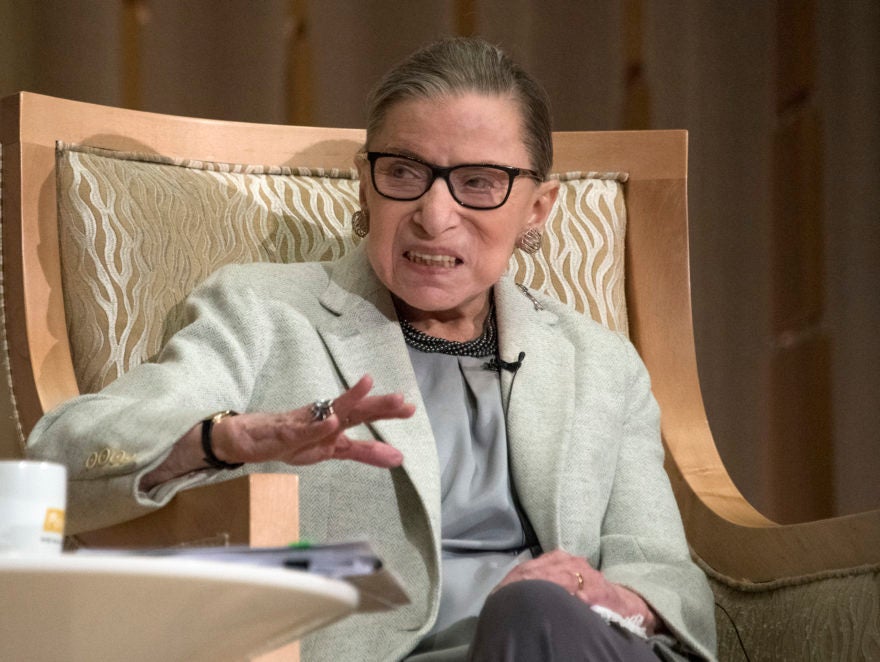Ruth Bader Ginsburg says she will serve as long as she has ‘steam’.
Published February 1, 2018

Associate Justice of the Supreme Court of the United States Ruth Bader Ginsburg appears at Adas Israel Congregation in Washington, DC on Thursday, February 1, 2018.
Credit: Ron Sachs / CNP
WASHINGTON (JTA) — Justice Ruth Bader Ginsburg told a Jewish audience that she would serve on the Supreme Court as long as she felt up to it.
Ginsburg, appearing Thursday at a Forward event at Adas Israel synagogue in Washington DC, appeared to confirm recent reports that she plans on serving through Donald Trump’s presidency.
“As long as I can do the job, i will be here,” she said to applause, after joking that she no longer is able to set as a deadline the 23 years Louis D. Brandeis served on the court. “I’m the longest sitting Jewish justice,” she said. “So I can’t use that.”
Ginsburg, 84, nominated by President Bill Clinton, has served since 1993. Court reporters said last month that she seemed to signal her intention to wait out Trump when she hired clerks for terms through 2020.
Ginsburg, unusually for a Supreme Court justice, criticized Trump during the 2016 campaign, calling him a “faker.” She later apologized. She is one of the most liberal judges on its bench.
Ginsburg said she drew inspiration from Jewish teachings and her upbringing in an observant home. “Devorah was a prime mover in this venture,” she said, referring to the biblical prophetess and judge.
A champion of the Equal Rights Amendment in the 1970s, when she was gaining fame as a constitutional lawyer, she said she still favored its passage, although doing so is a daunting challenge. (A constitutional amendment must be passed by 38 states.)
“I have three granddaughters,” she said. “I would like them to see in the Constitution that men and women are persons of equal citizenship stature.”
She spoke with Forward editor in chief Jane Eisner about her fascination with American Jewish history. Ginsburg seemed equally taken with the lives of Brandeis, the first Jewish Supreme Court justice, and Judah Benjamin, a slave owner and a member of the Confederate cabinet.
“Jews come in all sizes and shapes, and some are very good, and some are not so good,” she said, noting that both Benjamin and Brandeis faced anti-Semitism on the job.
Speaking of how her Jewishness informed her judicial philosophy, she said she believed that the brutality toward Jews U.S. troops found in Nazi Europe during World War II helped end segregation.
The dissonance was unbearable for Americans after that, she said.
“We were fighting a war against odious racism and our own troops until the end of that war were rigidly separated by race,” she said. “I consider World War II one of the major compelling forces to the Brown vs. Board of Education decision.” That 1954 Supreme Court ruling made school segregation illegal.
Ginsburg, in 1993, was the first Jewish justice on the court since the late 1960s, and she soon faced her first challenge. The Supreme Court bar inscribed its certificates “in the year of our Lord,” and Orthodox Jews who were admitted found themselves unable to display them. They appealed to her to make their case.
The bar association tried to win her over with an appeal to custom. She quoted someone as telling her, “It was good enough for Brandeis, it was good enough for (Benjamin) Cardozo, it was good enough for (Felix) Frankfurter, it was even good enough for (Arthur) Goldberg
“And I said it was not good enough for Ginsburg,” she said. As a result, now Supreme Court bar members have an array of choices of how to inscribe the year on their certificates.
Ginsburg was playful and appeared to enjoy herself. Asked Eisner’s traditional last question for interviews, her favorite type of bagel, Ginsburg bowed her head and placed a hand to it, affecting deep concentration.
“New York poppyseed,” she said –the same choice that Barack Obama and Benjamin Netanyahu had selected.














